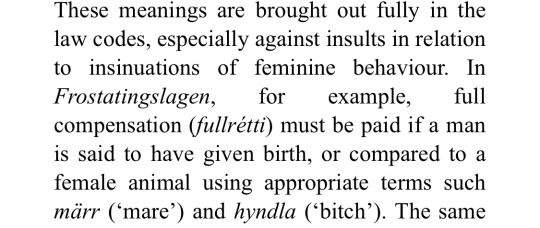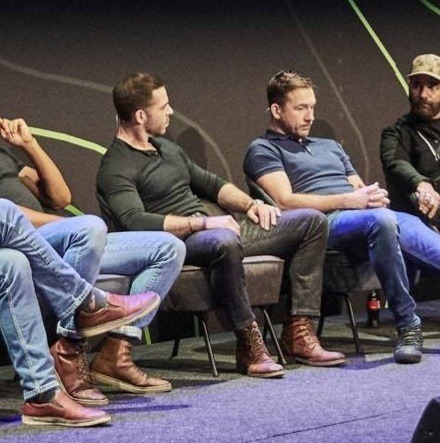#neil price
Text
Book Review of 'A History of the Vikings: Children of Ash and Elm' by Neil Price

This is probably singlehandedly one of the best academic books I've read as a pagan addressing the Viking era and its people's.
The author did a PHENOMENAL job of using academic sources (archaeology, literature, historical linguistics, etc) to really paint a living picture of the peoples being discussed in their entirety. The author left room for the peoples spiritual/supernatural believes that I don't often see done by writers who are not writing specifically for a pagan audience.
It was deeply refreshing and I sincerely hope to see more academic authors following in their footsteps in the years to come
#pagan#paganism#paganblr#norse#norse paganism#norse polytheism#scandinavian#Scandinavian paganism#Scandinavian polytheism#vikings#viking era#book#books#book review#Neil Price#children of ash and elm#blackcrowing
85 notes
·
View notes
Text
Strangely, Asgard also contained temples, cult buildings where the gods themselves made offerings—but to what or whom? The mythology of the Vikings is one of only a tiny handful in all world cultures in which the divinities also practised religion. It suggests something behind and beyond them, older and opaque, and not necessarily ‘Indo-European’ at all. There is no indication that the people of the Viking Age knew what it was any more than we do.
Neil Price, Children of Ash and Elm
#book quotes#children of ash and elm#norse mythology#vikings#norse#viking history#books and libraries#literature#books and reading#Neil price
69 notes
·
View notes
Text

this is like poetry to me
23 notes
·
View notes
Text
"In a literal sense, the Vikings are of course people of the past, dead and gone—but at the same time they inhabit a curiously haptic kind of prehistory, one that appears to return whatever pressure is applied to it. Many have been tempted to put their fingers on the scales of hindsight and imagined that the impulse to do so came not from themselves but through the revelation of hidden truths buried by time. Medieval monks and scholars reinvented their pagan ancestors either as nobly misguided forebears or as agents of the devil. In the manuscript illuminations of Romance literature, with a kind of Orientalist prejudice, they became Saracens, enemies of Christ depicted with turbans and scimitars. In Shakespeare’s England, the Vikings were taken up as violent catalysts in the early story of the kingdom’s greatness. Rediscovered during the Enlightenment as a sort of ‘noble savage’, the figure of the Viking was enthusiastically adopted by the nationalist Romantics of the eighteenth and nineteenth centuries. Searching for their own emerging identities, Victorian imperialists scoured Scandinavian literature looking for suitably assertive northern role models, expressing the manifest destiny of the Anglo-Saxons through their Nordic cousins. The logical end of that trajectory came a century later, when the Nazis appropriated the Vikings in pursuit of their racist fictions, elevating them as a spurious Aryan archetype; their modern successors still plague us today. Elements of the broad Pagan community now seek a spiritual alternative that draws inspiration from Viking religion, with Tolkienesque flavourings added to a cloudier Old Norse brew. All these and many more, including today’s academics and the audiences for historical drama, have taken the fragmentary material and textual remains of the Vikings and recast them in moulds of their choosing. At times it can seem that the actual people have almost disappeared under the cumulative freight they have been made to bear."
- Neil Price, “Children of Ash and Elm: A History of the Vikings”
#history#norse history#vikings#viking age#viking history#neil price#children of ash and elm#this was a phenomenally detailed and comprehensive book#queue#mine
42 notes
·
View notes
Quote
The nine stone packings at Götavi also raise an important and recurring component of the Viking mind: the sacred number. Nine - and its square root, three - appears numerous times in the mythological tales of the Norse. The sea-deities Aegir and Rán have nine daughters, the spirits of the waves; Heimdall has nine mothers; the giant Baugi has nine thralls; the beautiful Menglod has nine attendants; Gróa has nine protective charms; Odin has eighteen spells - twice nine; Thrivaldi, another giant who is slain by Thor, has nine heads. Freyr waits for his lover and later wife, Gerthr, for nine nights, the same length of time that Odin hangs on the tree in self-sacrifice, and sweats between the fires in 'Grímnir's Sayings', and makes his long ride to Hel on Sleipnir. In Valhöll, on every ninth night eight rings drop from the great gold ring, Draupnir (thus making nine in all), the source of Odin's wealth. The Muspell princess Laegjárn has a chest that must be closed with nine locks, one by one. The list goes on and on, and is replicated in the human world of Midgard: according to Adam [of Bremen] the great sacrifices at Uppsala last for nine days and are held every nine years, and nine creatures of each kind are killed. (In assessing the veracity of Adam's text, by the way, one might ask how he could have invented just that little detail to fit so well with wider picture he could not have known about.)
Neil Price, from Chapter 7 of “The Children of Ash & Elm | A History of the Vikings”, Penguin Books, 2020
14 notes
·
View notes
Text


getting real emotional over this
4 notes
·
View notes
Text
The institution of slavery had long antecedents in Scandinavia, probably going back thousands of years before the time of the Vikings. By the eighth century, there was already a considerable population of unfree people living in the North, their condition being largely a hereditary one built up over generations. In the Viking Age, this picture changed dramatically because for the first time Scandinavians began to make the active acquisition of human chattel a key part of their economy. This was one of the primary objectives of the Viking raids and military campaigns, and the results was a massive increase in the numbers of enslaved people in Scandinavia.
Let it therefore be clearly stated: the Vikings were not only slavers, but the kidnapping, sale, and forced exploitation of human beings was always a central part of their culture.
Neil Price, Children of Ash and Elm
2 notes
·
View notes
Text
Cooking implements have been most often been found in the graves of male vikings. Make of that what you will.
2 notes
·
View notes
Text
A strong sense of the numinous place courses through Norse poetry and even runic inscriptions, created by minds in tune with their environment. The same mind-set is visible in their material culture, in every available surface—including the human body—covered in interlaced designs, writhing patterns, animals, and other images that were imbued with meaning. Their world hummed with life, but its boundaries, both internal and external, were in many senses more permeable than ours, always and constantly connected by winding paths to the realms of the gods and other powers. —Neil Price, Children of Ash and Elm: A History of the Vikings
1 note
·
View note
Text



The visual of the vikings suing each other over getting called a bitch is so funny to me
#vikings#history#ergi#this book is about viking magic and this section is about#how practicing seidr as a man was morally poluting feminizing and queering#but this part made me laugh#another viking draws a picturing of you getting fucked and the laws saws you can kill him about it skdhdnsknsns wild#nid#ancient norse#neil price
1 note
·
View note
Text
daddy issue? I LOVE DADDY ISSUES 🫶❤️




#simon riley x reader#samuel roukin#simon ghost riley#simon riley x you#ghost cod#simon ghost x reader#ghost imagine#ghost x reader#price x reader#john price#john price x reader#barry sloane#graves x reader#phillip graves#warren kole#soap mw2#soap x reader#soap cod#john soap mactavish#neil ellice
2K notes
·
View notes
Text

"...history is nothing if not a suppositional discipline, sometimes akin to a sort of speculative fiction of the past." - Neil Price
#A study post for people who's spaces aren't aesthetic#some of us are normal and only study at our very average houses#A history of the vikings: children of ash and elm#neil price#Yggdrasil#self esteem#studying#studyblr#aesthetic#aestheitcs#academic#academics
2 notes
·
View notes
Text
🙂🙂 🤨🤨


Price and his two sons teammates
#captain price#price#john price#soap#soap mactavish#john mactavish#john soap mactavish#kyle garrick#kyle gaz garrick#gaz#call of duty#call of duty modern warfare#call of duty mw2#cod#modern warfare#modern warfare 2#elliot knight#barry sloane#neil ellice
6K notes
·
View notes
Text
Neil at an event in Amsterdam for modern warfare II with Barry Sloane and Elliot Knight





some photos without cuts



#call of duty#neil ellice#johnny soap mactavish#soap cod#barry sloane#john price#captain price#cod mw2#elliot knight#gaz#gaz cod
3K notes
·
View notes
Quote
The world of sorcery looms large in Viking spirituality, as do the women and ergi men who practised it. Their role in Norse life and thought was a crucial one, but it has been much overlooked. More so than those around them, these special women and men were familiar with the sutures of the world. They knew the places were different aspects of reality overlapped, and also the gaps left sometimes between. In their difference from other, these workers of magic seem to have been forced to the edges of society - but it was also there that they found their power. There is a sense in which they straddled the rivers between the realms, leaving footprints on both banks.
Neil Price, from Chapter 7 of “The Children of Ash & Elm | A History of the Vikings”, Penguin Books, 2020
16 notes
·
View notes
Text
Fascinating insights into the nature and reality of the early missions can be had from sources such as Widukind’s History of the Saxons, written around 968, which describes the conversion of a later Danish king. From the ambiguous way in which he charts the context of the royal baptism, it is clear that while the Danes are in many senses Christians, they also happily retain many of their earlier beliefs. The task of the missions was not conversion, as such, but the practical demonstration of Christ’s power through action.
There is a remarkable glimpse of how this worked in practice through a document known as Heliand, ‘The Saviour’. Written in Old Saxon during the first half of the ninth century, it is a paraphrase of the gospel for a Germanic audience, tweaked for their sensibilities and pitched almost as a Norse saga though with biblical heroes. Thus we read of Jesus’s birth in Galileeland, his later travels to Jerusalemburg, and how the Lord lives in a great hall in the sky (clearly Valhöll). The Lord’s Prayer is in ‘secret runes’, Peter is given command over the gates of Hel (with one L), and so on. Satan’s temptation of Christ takes place in a northern wilderness filled with vague forces, ‘powerful beings’ that seem to live among the trees, and one wonders what this implies of the traditional Northern beliefs that were known to the Christian clerics. By the same token, Jesus’s disciples are ‘warrior-companions’, framed in the language of a warlord’s retinue, and the Last Supper is the ‘final mead-hall feast’. Even God is called by Odinnic epithets such as ‘Victory-Chieftain’ and ‘All-Ruler’. This is the kind of message that was taken into Scandinavia by the first missionaries-a doctrine meshed with the ancestral stories of the North and following a model found in many other conversion histories.
It has sometimes been suggested that the Scandinavians’ adoption of Christianity was mostly a veneer-lip service to the outward trappings of belief combined with regular church attendance, but in reality merely a thin covering over the old ways that persisted beneath. In all the debate concerning afterlives and the varying destinations offered by the traditional customs and the new religion, one wonders whether Viking-Age people might actually have decided where they wished to go after death. If so, what did they make of a faith in which the fate of a person’s immortal soul was dependent on living a certain kind of life? It is hard to overstate how alien this concept may have seemed, although a cornerstone of many world faiths today.
The religious context of the sources is crucial here and affects the material culture as well. Much of what is known about the pre-Christian thought-world of the Vikings comes to us through the writings of, precisely, Christians. Even the framing story of this book-the creation of Ash and Elm-is relevant to the retrospective filter: how much of a coincidence is it that the ‘first couple’ in Norse cosmology have names beginning with A and E? Although the meaning of Askr/Ash is unequivocal, Embla is less certain. ‘Elm’ is the most commonly accepted translation, but the actual noun for an elm tree (almr) is masculine, and the etymology is convoluted. ‘Vine’ is another possibility, though this requires an ultimate derivation from Greek, and from there the scholarly debate starts to meander into the thickets of postulated Indo-European linguistic heritage. This kind of unresolved confusion-the ambiguities, contradictions, and possibilities-are all typical of the Viking-Age spiritual palimpsest, as we see dimly in the rear-view from more than a millennium in its future.
Neil Price, Children of Ash and Elm
1 note
·
View note